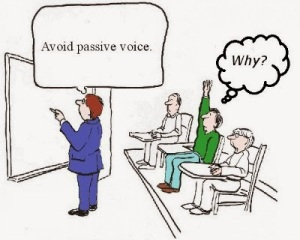 Recently, I took part in a workshop in the Learning Services Centre called “Enhancing Your Writing Style.” In the workshop we discussed different elements of effective writing which can be used to enhance academic writing. The part of the session that I got the most out of was the discussion about active and passive voice. I don’t know about you, but the only thing I had ever been told about passive and active voice, prior to the workshop, was a single instruction in a syllabus. The instruction provided was “do not write in passive voice.” There was no explanation of what passive voice was, nor what active voice was, or how to change from passive to the correct form of writing. I managed to complete the assignment without using too much passive voice, but I still did not know what the difference between the two was!
Recently, I took part in a workshop in the Learning Services Centre called “Enhancing Your Writing Style.” In the workshop we discussed different elements of effective writing which can be used to enhance academic writing. The part of the session that I got the most out of was the discussion about active and passive voice. I don’t know about you, but the only thing I had ever been told about passive and active voice, prior to the workshop, was a single instruction in a syllabus. The instruction provided was “do not write in passive voice.” There was no explanation of what passive voice was, nor what active voice was, or how to change from passive to the correct form of writing. I managed to complete the assignment without using too much passive voice, but I still did not know what the difference between the two was!
Fast-forward to the workshop and I finally got an explanation of what the two are, and how to write them as well! Since I had no idea what the different voices were, I decided to write a post explaining the differences between the two voices for others who are unsure.
Active Voice
When writing in active voice, the subject in your sentence does/did or will do the action that is expressed in the verb. In some cases, there is an object in the sentence as well. For active voice, the subject is the doer of the action and the object is the receiver of the action. To structure a sentence in active voice:
Doer of the action (Subject) + Action (Verb) + Receiver of the action (Object; if there is one)
hhhhhhhhhhhhh![]()
Example: The lack of rain seriously affected the water levels in Alberta.
(Subject) (Verb/Action) (Object)
Example: The children decided to play hide and seek.
(Subject) (Verb/Action) (Object)
Passive Voice
When writing in passive voice, the subject does not do the action expressed by the verb. Instead, the subject receives the action. For passive voice, the subject has the action done to them. The structure of a sentence in passive voice is:
Form of “to be” + Past participle OR Subject + Action + Doer of the action
![]() Example: The water levels of the lakes in Alberta were seriously affected by the lack of rain.
Example: The water levels of the lakes in Alberta were seriously affected by the lack of rain.
hhhhhhhhhhh(Subject) (Verb/Action) (prepositional phrase)
Example: The water levels of the lakes in Alberta were seriously affected by the lack of rain.
hhhhhhhhhhhhhhhhhhhhhhhhhhhhhhhh(Form of “to be”) (Past Participle)
There are many forms of “to be” (e.g. is, are, am, was, were, has been, have been, being, etc.) and while oftentimes sentences with forms of “to be” are passive, it does not necessarily indicate they are. An example would be “is” describing a state of being: John is an intelligent student. Keep an eye out for these trickier sentences which may or may not be passive voice!
Now that we know what passive and active voice are we should consider why we are told to write in active voice. There are many reasons for writing in active voice: writing is more direct, concise, action oriented and engaging. As well, a paper heavily peppered with passive voice can be seen as “wordy.” By writing in active voice your papers will have more clarity, less wordiness, be more concise and less vague or abstract. Now you know what passive voice and active voice are, and how to write in either. I hope this helps with your future writing assignments!
Hannah E.
Peer Mentor
Works Cited
“Passive Voice.” The Writing Centre. The University of North Carolina at Chapel Hill, n.d. Web. 2 July 2014.
“Active vs. Passive Voice.” Language Portal of Canada. Government of Canada, 17 April 2014. Web. 2 July 2014.
